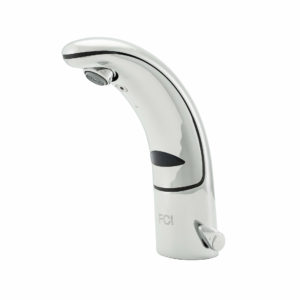However, the pandemic has made us all more conscious of the spread of germs in our homes, and more families are seeking hygienic products to keep their families safe. This has placed more emphasis on touchless technology including touchless kitchen faucets. Here is how touchless kitchen faucets work and why they are so popular with families with kids.
How Touchless Kitchen Faucets Work
Touchless faucets use motion detectors to activate water flow. A swipe of the hand triggers the sensors, sending a message to the faucet to allow water flow. Once the movement stops, the water turns off. The key components of a touchless kitchen faucet include:
- Sensors: Motion sensors send a signal to the valve when motion is detected. This in turn activates the faucet by triggering the valve to allow water to flow. When movement stops, the water is stopped. Sensors use infrared light or ultrasonic energy located somewhere in the spout.
- Solenoid Valve: When the sensor senses movement it sends a signal to the solenoid valve. When there is movement, it creates a pull action to release water, while lack of movement triggers a push action to stop the flow. A rubber-like disc is in place to control water flow and moves into position based on the signals the solenoid valve receives.
- Power Source: Electricity is required to operate the sensors and valve. In some cases, the faucet might require an electrical outlet, while others use batteries. Battery operation is preferred as most kitchen sinks are not directly located near a socket. You also waste less energy because electrically powered faucets require a continuous flow of electricity to operate while battery-powered faucets do not.
- Spout: The final part of your touchless kitchen faucet is the spout. This is where the water comes out. Spouts come in many different materials and styles, including goosenecks ideal for kitchen use.
The remaining parts connect to your water source and are similar to traditional faucets.
Reducing Water Wastage
Touchless faucets are activated with the wave of a hand. However, they also turn off automatically when they sense they are no longer needed. Kids are notorious for leaving the tap running. Running water costs money and also leads to water waste. Once you are finished using the faucet, it turns off automatically stopping water flow. However, this feature is also handy when you are working at the sink, constantly turning the water on and off. You can activate the water flow only for as long as you need it to rinse something off or get some water while cooking. It turns off and is ready when you need it again. Water conservation will make a noticeable difference in your monthly water bill if you choose a touchless faucet.
Reduced the Spread of Germs
Not surprisingly touchless kitchen faucets also reduce the spread of germs. Although COVID is always top of mind for parents, we can’t forget all the other germs lurking in the home. Preparing raw meat is a perfect example. Hopefully, we all wash our hands after cutting up chicken for example, but we have to touch the tap to do so.
This leaves germs on the tap for the next person. With touchless technology, a wave of the hand activates water flow and you don’t leave behind the germs that can cause salmonella. This reduces the risk of transferring the germs back onto your own hands or to other family members.
Cleaner Faucet
Whether you were working in the garden, painting, or doing arts and crafts with the kids, washing your hands at the kitchen sink is an everyday occurrence. However, when hands are messy and grimy, it can make a mess of your faucet. Touchless kitchen faucets are never touched so they stay clean regardless of the dirty mess on your hands.
Easier Operation
Young children and older adults can have difficulty turning on taps due to small hands or arthritic joints. With a touchless kitchen faucet, anyone can still easily turn on the water with a wave of the hand. This is an important feature in multi-generational households where small kids, parents and grandparents all use the taps. However, it is also easier to perform kitchen duties such as filling large pots with water or rinsing off dishes.
What’s the Difference Between Touch and Touchless Kitchen Faucets?
There are actually two kinds of new kitchen faucet technology available: touch faucets and touchless faucets.
A touch faucet is not your standard tap with handles but instead is activated by touching the actual spout of the faucet. These are easier to use than your traditional taps, as you can activate them with your elbow if your hands are full. Some people prefer this as it provides more control over the water, and also is less likely to trigger the tap if you are just putting something in the sink like a dirty dish.
However, you still risk contamination because everyone still has to touch the spout to trigger the water. You also still have to worry about running water as you have to tap the faucet to turn it off. This is why generally speaking the touchless kitchen faucet is still the preferred choice for families.
How to Choose the Best Kitchen Faucet for your Needs
If you aren’t sure which type of faucet is best for your kitchen, consider the following:
- Do you often fill large pots for cooking? If yes, a touchless or touch-gooseneck faucet is best for you.
- Do you have small children or elderly adults in the home? If yes, the touchless kitchen faucet is the easiest to operate.
- Do you want to save water? If yes, the touchless kitchen turns off automatically when not in use.
- Do you do a lot of messy work in your home that requires hand washing? If yes, the touchless kitchen faucet is best.
Go touchless in your home today. Get in touch with an industry expert for more information.







